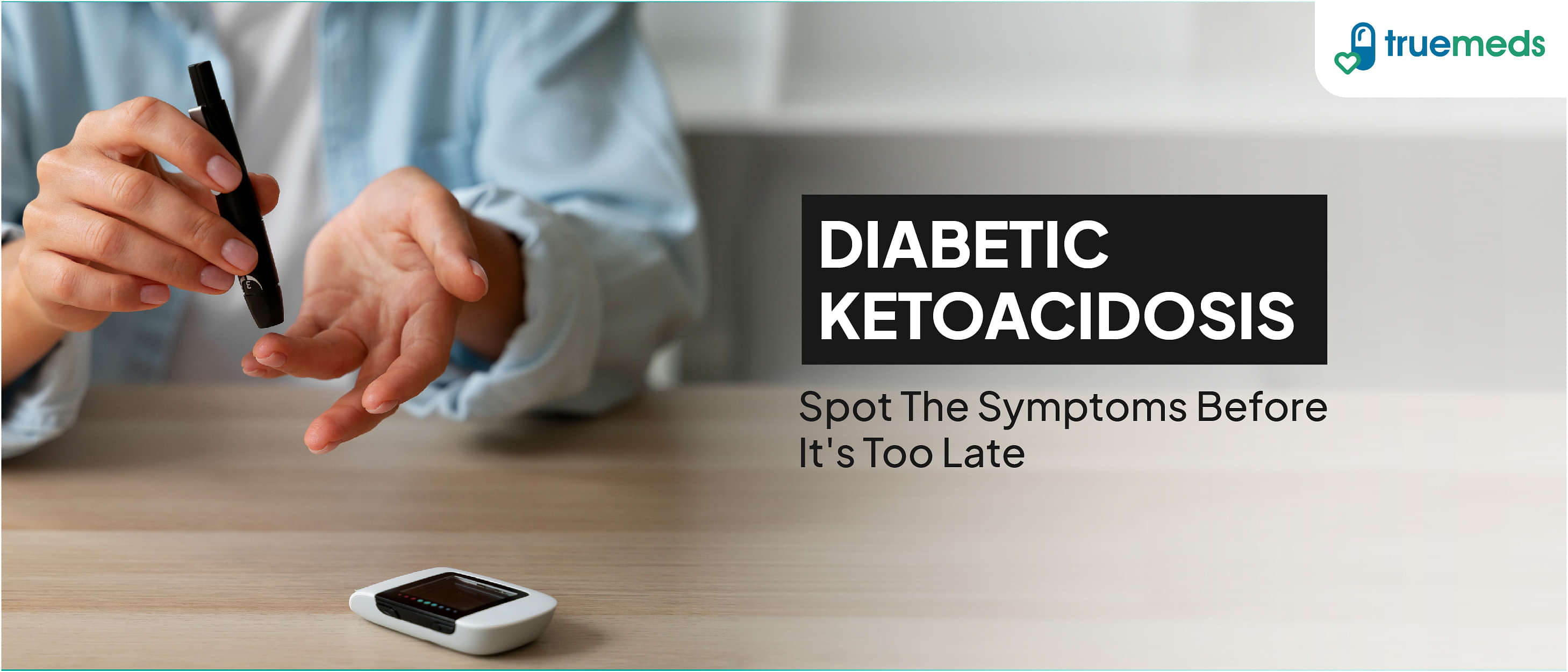Diabetes Ketoacidosis Symptoms, Treatment and Complications
Last updated on : 18 Mar, 2025
Read time : 8 min
Diabetic ketoacidosis is a serious complication of diabetes that occurs when the body lacks enough insulin to use glucose for energy. This potentially life-threatening condition is characterised by high blood sugar levels, the production of ketones, and a resulting acidic blood environment. Recognising the signs and symptoms of diabetic ketoacidosis is essential for early detection and effective management to prevent severe outcomes.
What is Diabetic Ketoacidosis?
Diabetic ketoacidosis is a critical condition that develops when the body does not have sufficient insulin to utilise glucose for energy, leading to several metabolic abnormalities:
- Insulin Deficiency: A lack of insulin prevents glucose from entering cells, forcing the body to break down fat for energy.
- Ketone Production: The breakdown of fat results in the production of ketones, which become toxic in excessive amounts.
- Hyperglycaemia: High blood sugar levels, often exceeding 250 mg/dL, are a hallmark of diabetic ketoacidosis.
- Metabolic Acidosis: The accumulation of ketones leads to an acidic blood environment.
- Dehydration: Frequent urination and fluid loss are common consequences of diabetic ketoacidosis.
Symptoms of Diabetic Ketoacidosis
The symptoms of diabetic ketoacidosis can develop rapidly, indicating a serious medical emergency that requires immediate attention. Common signs and symptoms include:
- Frequent urination and increased thirst due to high blood sugar levels.
- Signs of dehydration, such as dry skin, dry mouth, and decreased alertness.
- Deep, rapid breathing (Kussmaul breathing) as the body attempts to compensate for the acidic blood.
- Fruity or sweet-smelling breath due to the presence of ketones.
- Nausea and vomiting, which can exacerbate dehydration.
- Headache resulting from dehydration and metabolic imbalances.
- Muscle stiffness, aches, and general discomfort.
- Abdominal pain and stomach discomfort.
- Flushing and redness of the face due to metabolic changes.
Early Signs of Diabetic Ketoacidosis
Diabetic ketoacidosis is a serious complication that can develop gradually, but it is essential to recognise the early warning signs and seek medical attention promptly. The key early symptoms include:
- Increased thirst and more frequent urination
- Strong urge to eat or intense hunger
- Dry mouth and skin, indicating dehydration
- Severe headache
- Fatigue or decreased energy levels
- Fruity-smelling breath, similar to pear drops or nail polish remover
Causes of Diabetic Ketoacidosis
Several key factors can contribute to the development of diabetic ketoacidosis. The primary causes include:
- Insufficient insulin due to missed insulin shots, a clogged insulin pump, or incorrect dosing
- Illness, which can make it difficult to manage blood sugar levels effectively
- Physical injury or stress, such as heart attacks, strokes, or severe injuries
- Alcohol or drug use that disrupts proper blood sugar management
- Certain medications, including diuretics and corticosteroids
- Uncontrolled blood sugar levels, especially in those with type 2 diabetes who may require insulin
Diabetic Ketoacidosis Medication and Treatment
Treatment for diabetic ketoacidosis is considered a medical emergency and typically involves hospitalisation. The key components of diabetic ketoacidosis treatment include:
- Insulin administration to lower blood sugar levels and stop the production of ketones
- Fluid replacement through intravenous fluids to replenish lost fluids and dilute high blood sugar
- Electrolyte replacement, such as sodium and potassium, to maintain proper bodily functions
- Medications for underlying conditions, such as infections, that may have triggered the diabetic ketoacidosis
- Close monitoring of blood sugar, ketone levels, and overall health until the condition stabilises
Risk Factors of Ketoacidosis
Several factors can increase the likelihood of developing diabetic ketoacidosis, particularly in people with diabetes:
- Type 1 diabetes, although individuals with type 2 diabetes can also be at risk, especially under stressful conditions
- Missing insulin doses, using expired insulin, or issues with insulin pump functionality
- Illnesses and infections, such as pneumonia or urinary tract infections
- Physical or emotional trauma, including surgery, heart attacks, or strokes
- Poorly managed diabetes, including not monitoring blood sugar levels or adhering to treatment plans
- Alcohol and drug use, such as cocaine
| Quick Stats: Globally, diabetic ketoacidosis occurs in 4-8% of patients with Type 1 diabetes annually. Its prevalence in Type 2 diabetes is lower but increases in situations of stress, infection, or undiagnosed diabetes. In the U.S., about 20-30% of newly diagnosed Type 1 diabetes cases present with diabetic ketoacidosis. |
Complications of Diabetic Ketoacidosis
Diabetic ketoacidosis can cause several serious complications if not properly managed or treated promptly. These may include:
- Hypoglycaemia (low blood sugar) due to rapid correction of blood sugar levels during treatment
- Hypokalaemia (low potassium levels) caused by treatment with fluids and insulin, affecting the heart, muscles, and nerves
- Cerebral oedema (brain swelling), particularly in children, due to rapid adjustment of blood sugar levels
- Severe dehydration resulting from high levels of glucose and ketones in the blood
- Permanent brain damage or death if diabetic ketoacidosis is left untreated
Diabetic Ketoacidosis Diagnosis
Diagnosing diabetic ketoacidosis involves identifying characteristic symptoms and laboratory findings. Key points in the diagnostic process include:
- Clinical presentation, such as vomiting, abdominal pain, fatigue, and altered mental status
- High blood glucose levels, typically above 250 mg/dL
- Presence of ketones in the blood and/or urine, indicating metabolic acidosis
- Low blood pH levels, signifying metabolic acidosis
- Electrolyte imbalance, particularly in sodium, potassium, and chloride levels
- Laboratory tests, such as complete blood counts, blood cultures, and imaging studies, to identify underlying causes like infections
Prevention of Diabetic Ketoacidosis
Preventing diabetic ketoacidosis is essential for people with diabetes. Here are some key preventive measures:
- Monitor your blood sugar levels regularly, especially when ill or if your blood sugar is high.
- Take your diabetes medications as prescribed and adjust insulin dosages as advised by your doctor.
- Check ketone levels in your urine or blood, particularly when sick or if your blood sugar is over 250 mg/dL.
- Stay hydrated by drinking plenty of sugar-free, caffeine-free liquids and follow a regular meal plan.
- Develop a diabetic ketoacidosis emergency plan with your doctor.
When to See Your Doctor
If you suspect that you or someone else is experiencing diabetic ketoacidosis, it is vital to seek immediate medical attention. Contact your doctor right away if you experience symptoms such as excessive thirst, frequent urination, fruity-smelling breath, vomiting, stomach pain, or difficulty breathing. Additionally, if your blood sugar levels are consistently high (over 300 mg/dL) or you have moderate to large amounts of ketones in your urine or blood, seek medical help promptly. Early detection and treatment are essential for managing diabetic ketoacidosis effectively and preventing serious complications.
Conclusion
In conclusion, diabetic ketoacidosis is a serious complication of diabetes that demands swift recognition and treatment. By maintaining good blood sugar control, following your insulin therapy, and monitoring ketone levels, you can significantly lower the risk of developing diabetic ketoacidosis. Always follow your doctor’s advice and have an emergency plan in place to manage diabetic ketoacidosis effectively. With proper prevention, early detection, and prompt medical care, individuals with diabetes can avoid the life-threatening consequences of this condition and maintain their overall health and well-being.
Frequently Asked Questions (FAQs)
Treatment for diabetic ketoacidosis involves administering insulin, fluids, and electrolyte replacement through an IV to correct high blood sugar, dehydration, and ketosis.
The first step in managing diabetic ketoacidosis is initial rehydration using isotonic saline to improve circulatory volume and tissue perfusion.
Low-dose short-acting regular insulin, administered intravenously, is used to treat diabetic ketoacidosis.
Ketones can be reduced by administering insulin, drinking non-carbohydrate fluids, and correcting high blood sugar levels.
Ketones can be controlled at home by regularly checking blood glucose and ketone levels, following your insulin treatment plan, and contacting your healthcare team if levels are high.
Diabetic ketoacidosis generally starts at blood sugar levels over 250 mg/dL, with severe cases often having levels above 300 mg/dL.
Ketoacidosis can affect the brain, heart, and lungs, leading to severe complications if left untreated.
The initial treatment for diabetic ketoacidosis is immediate hospital admission for intravenous insulin, fluids, and electrolyte replacement.
References
Disclaimer
Our healthcare experts have carefully reviewed and compiled the information presented here to ensure accuracy and trustworthiness. It is important to note that this information serves as a general overview of the topic and is for informational purposes only. It is not intended to diagnose, prevent, or cure any health problem. This page does not establish a doctor-patient relationship, nor does it replace the advice or consultation of a registered medical practitioner. We recommend seeking guidance from your registered medical practitioner for any questions or concerns regarding your medical condition.
Popular Articles
Recommended Articles
Recent Articles
Top-Selling Medicines:
...View more
Top-Selling OTC:
...View more
Company
About UsHealth ArticleHealth StoriesDiseases & Health ConditionsAll MedicinesAll BrandsNeed HelpFAQSubscribe
Registered Office Address
Grievance Officer
Download Truemeds

Contact Us
Our customer representative team is available 7 days a week from 9 am - 9 pm.
v3.7.11
Our Payment Partners


























































